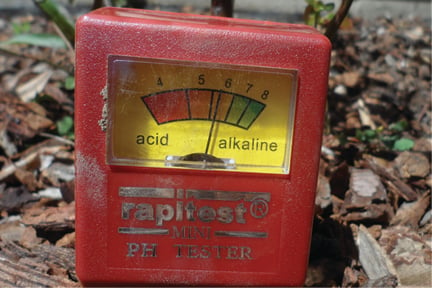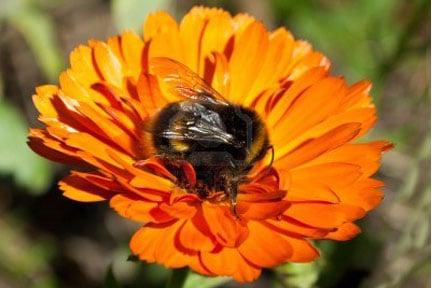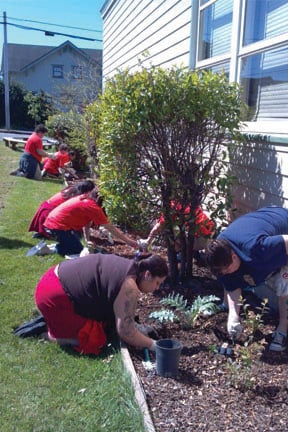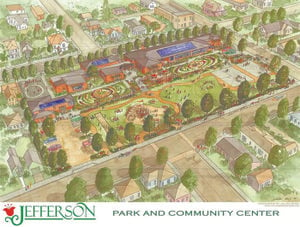
Stephanie Calderon and Michael Wold created a landscape design of the front area of the Jefferson Community Center and Charter school. The landscape included edible plants, xeriscape elements, and site specific soil assessment and solar requirement. This project was created to address food security and the access of it for low income and culturally diverse neighborhoods.
Background[edit | edit source]
The Jefferson Projectis a symbol of community revitalization through physical efforts of restoration and social action towards a safe and accessible community space. This project is created under the guidance of Heidi Benzonelli, Lonny Grafman, and Cal Poly Humboldt's Engineering 305 course (Spring 2013).
The Westside neighborhood is home to an estimated 3,800 residents with approximately 850 children. According to the Westside Community Improvement Association (WCIA), the Westside neighborhood is the most densely populated neighborhood in Eureka. The Jefferson Community Center and Charter School (JPCC), caters to the most ethnically diverse and low-income neighborhood in Eureka California.
The Westside Community Improvement Association (WCIA) formed in 2007 with intents on purchasing the vacant lot of the Jefferson School. WCIA has been awarded several planning and scoping grants from local agencies such as PG&E and the Calfresh Program.
In 2011, the WCIA was granted a California state community revitalization grant to create a park and restore the building to run as a community center and charter school. Plans for revitalization and renovation of the 70 year old school buildings began by removing black top areas and replacing them with playgrounds in order decrease urban blight and to increase open space for community interaction. This is just the beginning of the revitalization of this community space.
Project Description[edit | edit source]
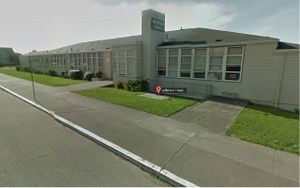
The objective of this project is to transform the landscape located at the front entrance of the Jefferson Community Center and Charter School. The landscape will be converted from traditional European style landscaping into a functional, aesthetically pleasing, edible landscape, consisting of various fruit trees, nut trees, berry bushes and herbs. The landscape will serve as safe access to organically grown foods for the greater Westside neighborhood residents and Jefferson Charter School students.
The chosen site was surveyed for sun exposure, and pH of soil. In addition, water usage of plants will be considered as a theme in the overall design. The final design of the edible landscape will incorporate the economic capacity of the organization, access to community donations, and community support through workdays.
Project Evaluation Criteria[edit | edit source]
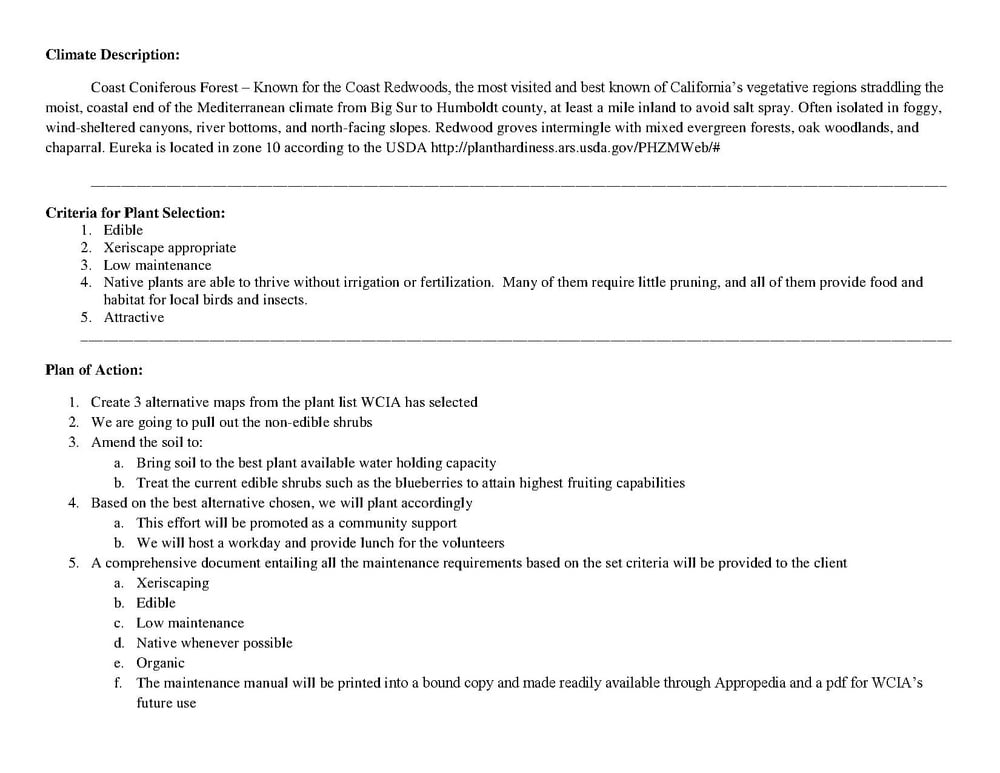
The following Criteria will be used to assess the success of this project. These criteria were chosen based on the suggestions of the Westside Community Improvement Association. The criteria was based on the analysis of Michael Wold and Stephanie Calderon and their conversation with WCIA representatives. The scale (1-10) represents the importance level of meeting the constraint of each listed criteria. 1 being lowest priority and 10 being the highest priority.
| Criteria | Constraints | Weight (1-10) |
|---|---|---|
| Maintainability | Community members will be able to participate in maintenance of landscape through volunteer workdays and workshops. This must be a low maintenance landscape. | 9 |
| Aesthetics | Must be pleasing to the eye and look professional. | 9 |
| Educational Aspect | Must include educational interpretive signage for the community. | 7 |
| Efficient Resource Use | Must incorporate xeriscape principles and low maintenance elements into design. Easy upkeep and little use of Eureka city water is a required design element on behalf of WCIA. | 10 |
| Accessibility | All structures such as planters and beds must be compliant with the Americans with Disabilities Act of 1990. | 8 |
| Budget | Must not exceed budget | 9 |
| Functionality | Successfully produces edibles such as fruits, vegetables, and herbs. | 10 |
Tentative Time Line[edit | edit source]
| Project | Started | Completion |
|---|---|---|
| Identify water usage zones on site | February 12 | February 22 |
| Identify sun and shade exposure on site | February 12 | February 22 |
| Identify appropriate plants that fit criteria of xeriscape, low maintainability, and productivity on the northwest coast | February 12 | February 22 |
| Present design options to clients (Westside Community Improvement Association) | February 23 | March 16 |
| Contact sponsors and donors through letters, PR, and networking | February 23 | March 2 |
| Source soil, plants, planters, and pet waste receptacle | March 3 | March 23 |
| Publicize a community work day for physical removal and amendment of soil | March 25 | April 7 |
| Remove non-edible (current) shrubs and bushes | April 7 | April 7 |
| Till and amend soil | April 7 | April 7 |
| Put edible plants into ground | April 8 | April 14 |
| Put pollinator attracting plants into ground | April 14 | May 4 |
| Deliver a maintenace plan and map of plants to WCIA | April 14 | May 4 |
| Present final product to client, community, sponsors, and Engineering 305 class. | May 15 |
Literature Review[edit | edit source]
This is a review of the available literature pertinent to the comprehensive edible landscape project at Jefferson Community Center and Charter School. This review includes an analysis of the Eureka, CA climate, temperature, and rainfall averages. These elements of climatic influence will assist in the selection of appropriate plants that fit the project's criteria of edible landscaping and xeriscape principles. In addition this review provides a basic introduction to xeriscape principles and the philosophy of edible landscaping.
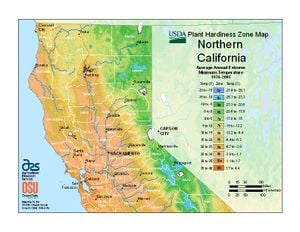
Climate Profile of the Region[edit | edit source]
The region is often isolated in foggy, wind-sheltered canyons, river bottoms, and north-facing slopes. Redwood groves intermingle with mixed evergreen forests, oak woodlands, and chaparral. Eureka is located in zone 10 according to the USDA Plant Hardiness Zone Map[1]
The average rainfall in Eureka, CA is an estimated 39.45 inch average per year. According to these numbers, the driest month in Eureka is July inches and the wettest month is December.
The average maximum temperature in Eureka is 58.6 degrees. In comparison, the minimum temperature average is an estimated 46.7 degrees. These averages are based off of records for the year of 2012 kept by the Western Regional Climate Center.[2]
Edible Landscape Basics[edit | edit source]
Landscaping has evolved in America's history. Initially highly productive gardens meant to fulfill the nutritional needs of rural families were landscapes main purpose.[3] However, with the advancement of agricultural science, monoculture, and rural flight to urban environments, landscaping lost the need of production and transitioned to an ornamental variety of shaped shrubbery and well manicured lawns. Edible landscaping on the other hand is an approach and practice in which unused, under utilized, and unproductive landscapes are rehabilitated and transformed.[4]The end goal of the transformation is a landscape, which produces various forms of plant species that yield multiple forms of edible foods and goods as well as meeting the need for eye pleasing aesthetics.[3][4]
There are many benefits, which an edible landscape can provide, from rare produce not obtained at your local market to the self-satisfaction of not supporting unsustainable macro monoculture.[5] Edible landscapes are an investment in ones property or neighborhood, by increasing topsoil, nutrient availability, recharging aquifers and more.[6] Edible landscapes can be a misnomer as well, for the goal can also be to attain other harvestable materials such as tea, die, fiber, or medicine.[5]
Appropriate plant selection is based on climate and the zones mapped out on the garden site. The number of plants selected should also be taken into consideration. Gain a perspective on the potential mature size of the plants to determine the space needed to reach its maximum size.[7]Once an initial list of plants has been created. Look into the competitive and may complimentary characteristics of plants that may share a space. Consider the addition of plants that attract pollinators.[7]
Xeriscaping Basics[edit | edit source]
Xeriscape gardening is designing a garden that uses minimal amounts of water to maintain the landscape, while complimenting the surrounding environment. Xeriscaping is derived from the Greek word xeros, meaning dry.[8]
The initial step towards understanding the water conservation capabilities on the identified site is to zone areas of water usage. Water usage zones are as follows: high (regular watering), moderate (occasional watering), and low (rainfall is enough). The following step is mapping out zones in relation to sun exposure.[7]If an area is zoned as 'high' usage, a number of methods can be applied to the soil to help water retention. Adding organic matter such as compost or leaf litter may increase the plant available water for plants. In comparison, soils that are dry can be tilled to create better aeration.[9]
Water plants early morning or early evening as sun is setting. This will reduce the amount of water that evaporates due to heat and overall it is a practice. Additionally, consider the rate of saturation of the soil (1 inch of watering equals 6 inches of wet soil depth).[10] Mulching serves a variety of needs in regards to soil and weeds. Mulching will keep the soil protected from evaporation and maintain a level of moisture. Mulching also assists in the control of erosion and fighting back weed.[9]
Seven Principles of Xeriscape Gardening[edit | edit source]
The concept of xeriscape gardening is comprised of seven water saving principles: planning a design, soil analysis, appropriate plant selection, turf planning, efficient irrigation, mulching, and maintenance.[7]
- Principle One: Planning and Design
- Principle Two: Soil Analysis
- Principle Three: Appropriate Plant Selection
- Principle Four: Turf Planning
- Principle Five: Efficient Irrigation
- Principle Six: Mulching
- Principle Seven: Maintenance Plan
Create a maintenance strategy that addresses the following elements[edit | edit source]
- Consider the reduction of fertilizer application. When applied, fertilizers assist plants in growth. More growth equals more water needs.:[7]
- Once plants have been put into their appropriate zones, wait a month of two and watch which plants flourish or establish steady growth. Remove plants that are growing poorly. This will save water and time invested into maintenance.:[7]
- Avoid pruning.:[7]
- Control weeds that occur at the base of the plant or in any competitive situation. Weeds also require water and thus will take the water from the intended plants.:[7]
Design and Implementation[edit | edit source]
Planning and Design Your Edible Landscape[edit | edit source]
There are a number of steps to consider before approaching the design board. You want to gather information about the exposure to element, nutrient, and water holding capacity of your site. Below is the step by step process we followed when implementing our plan.
Maintenance[edit | edit source]

A pdf document and hard copy were delivered to our client describing the pruning habits, pH soil requirements, and site map of the landscaped region.
Some Extra Tips[edit | edit source]
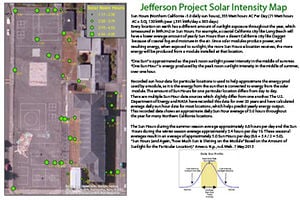
Using a solar pathfinder is easy and generates great results to help you design your edible landscape. Below is a quick video showing how to set up a pathfinder and collect data. Mike generated a map from the data collected to provide the WCIA with a reference of the sun exposure the front of the building receives for future landscaping.
Lessons Learned[edit | edit source]
When working with a non profit there is a level of flexibility that needs to be incorporated into your design. As we set a number for our budget, we quickly realized the project footprint was large and it would take quite a bit of funding for it for it to become a reality. We determined that community donations would be the best avenue to secure a number of plants and materials that were needed.
We received welcoming reactions from local business owners as they handed over a number of plants to our project. However, donors were willing to give us plants of their choosing. So we ended up with a number of plants that fit our criteria but with a few that did not. Working with a non profit community action provides an opportunity for diverse effort input. We want to express gratitude to the donating businesses and Westside residents for their hard work, input, and enthusiasm. We hope that you enjoy the fruits of your labor (literally).
Update October 2013[edit | edit source]
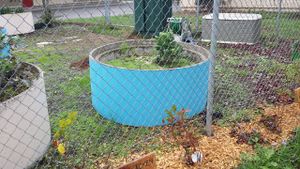
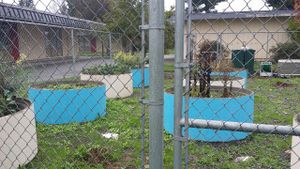
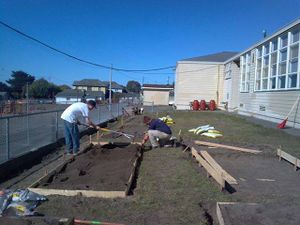
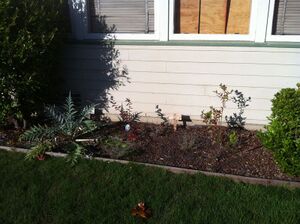
Upon visiting the site it was evident that the Jefferson Community center has maintained the garden, as well as added numerous new beds and plants. In addition to the initial gardens, 13 new beds have been added, consisting of herbs, kale, arrugala, asian greens, garlic, winter potatoes, onions, leeks, chives, spring lettuce, broccoli, brussel sprouts, strawberries, and various peas. After interviewing the head of the community center, Heidi Benzonelli, we learned that the California Conservation Corps, the Boys and Girls Club, and numerous community volunteers have utilized the edible landscape. The Boys and Girls club in particular, engaged in an intensive eight week summer camp where they built beds, planted new species, and harvested ripe plants. She also stated that the most successful and productive crops have been the blueberries, huckleberries, strawberries, and artichokes. Some of the plants, such as rhubarb, were not as successful and have since been relocated. In the future Heidi plans to add several more beds to the edible landscape with an even greater variety of plant species. Overall, Heidi considers the garden a huge success and a fantastic ongoing educational project for the community center.
Update October 2016[edit | edit source]
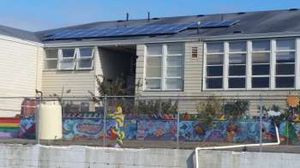
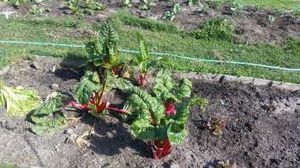

The Jefferson Community Center is a revolutionary community center that utilizes up-to-date sustainable technology with a unique community model that not only provides for the community around West Eureka, California, but also strengthens the community around them. As of fall 2016, the Jefferson Community Center is expanding to greater heights that will positively contribute to community around them and also others that may move into the community. In addressing issues around the community, the edible food park that Jefferson community is planning to build is a promising solution to those to who are hungry and are not able to afford a meal. This hundred percent, local, native, medicinal, edible, organic, garden will be provided for the community by the community.
Since 2013, the center has grown tremendously! Back in 2013 the organic garden beds were barely getting started, and today they are producing fruits such as strawberries, raspberries and vegetables such as squash and peas. What is truly impressive is the impact the garden has on the community and its members. According to Director, Heidi Benzonelli, the Jefferson Community Center garden provides over a hundred meals to after-school programs. Early Head Start, Head Start, and Seeds are a few examples of the community organizations that are dependent of garden. In interviewing her, she stated that they are preparing to do more for the community in the next couple of years. After interviewing Heidi, the center itself has been preparing for newer additions to the center. With help of Cal Poly Humboldt, the Jefferson Center will soon have a new computer lab that will be accessible to the public that are not able to use the computer. Asking Heidi about the community and security of the community center, she stated that the only part in which the community is able to get better if we give them the opportunity to do better, in doing so, Heidi is looking forward for the future remodeling of the Jefferson center that will lead to betterment of not only West Eureka but Eureka as a whole.[11]
Update October 2019[edit | edit source]
As friends and I came upon The Jefferson Community Center we were greeted by Bill Rodstrom, who has volunteered for many years helping to tend the edible landscapes and the gardens. What once used to be an unused elementary school in West Eureka, the densest neighborhood around is now a multi-purpose park with community-run programs aiming to enrich the lives of its community members. JCC created a community model that provides for low-income communities around while also strengthening the immediate community around them. The edible landscapes are one great example of community-based endeavors to teach children about gardening and cooking! The landscapes dedicated to edible crops utilize up-to-date sustainable technology such as solar panels, rainwater catchment systems, and have adjusted it's internal draining to more effectively water crops in an area that may flood easily. Since 2016, JCC has made alot of progress while still maintaining edible landscapes installed in 2013. These original planters still contain huckleberries, blueberries, peas, and artichokes! There have been new edible planters installed beside the stairs to the playground, along with a standing garden bed that is wheelchair accessible and contains basil and herbs! Also, in the front of the building, there have been additional trees planted that will add to the edible foliage on site. On the side of the building, there is a planter dedicated to tomatillo's used in the English speaking classes. Beside it, there is a grapevine and an apple tree and fig trees are riddled throughout the property. As of fall 2019, the Jefferson Community Center is expanding its edible gardens to the lots at the bottom right parking lot. The center does not seem to be slowing down in its goals.
Notes[edit | edit source]
- ↑ Plant Hardiness Zones. 2012. Eureka: http://planthardiness.ars.usda.gov/PHZMWeb/#
- ↑ Western Regional Climate Center. 2012, Period of Record Monthly Climate Summary. Eureka: http://www.wrcc.dri.edu/cgi-bin/cliMAIN.pl?ca2910
- ↑ 3.0 3.1 Creasy, Rosalind. 1982, The Complete Book of Edible Landscaping. San Francisco: Sierra Club
- ↑ 4.0 4.1 Kourik, Robert. 1986, Designing and Maintaining Your Edible Landscape. Santa Rosa: Metamorphic Press
- ↑ 5.0 5.1 Newman, Trevor. 2011, Roots to Fruits. New York: Roots to Fruits LLC.
- ↑ Superfisky, Kat. 2013, Weeding two monocultures with one hoe: How edible landscaping can simultaneously ease issues associated with industrialized agricultural production and America's obsession with the lawn.
- ↑ 7.0 7.1 7.2 7.3 7.4 7.5 7.6 7.7 Weinstein, Gayle. Xeriscape handbook: a how-to guide to natural, resource-wise gardening. Golden, Colo.: Fulcrum Pub., 1999.
- ↑ Ellefson, Connie Lockhart, Thomas L. Stephens, and Douglas F. Welsh. Xeriscape gardening: water conservation for the American landscape. New York: Macmillan ;, 1992.
- ↑ 9.0 9.1 Wang, Xinhao, Amy Burgess, and Jeff Yang. "A scenario-based water conservation planning support system (SB-WCPSS)." Stochastic Environmental Research and Risk Assessment 13 (2012): 1-13.
- ↑ Lehr, Jay H., and J. W. Keeley. Surface and agricultural water. Hoboken, N.J.: John Wiley & Sons, 2005.
- ↑ A special thanks for the staff of the Jefferson Community Center! Especially Mrs. Heidi Benzonelli, Director of the Jefferson Center.
References[edit | edit source]
Project Facilitators: Stephanie Calderon & Michael Wold
- Projects
- SDG03 Good health and well-being
- SDG04 Quality education
- SDG08 Decent work and economic growth
- SDG11 Sustainable cities and communities
- SDG12 Responsible consumption and production
- Engr305 Appropriate Technology
- Food and agriculture
- Culture and community
- Edible landscaping
- Jefferson Community Center
- Gardening

